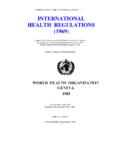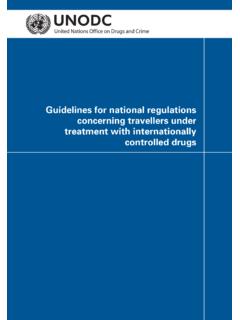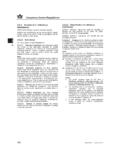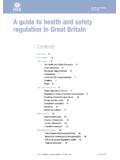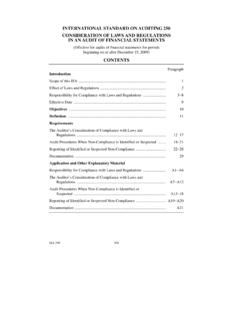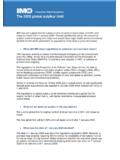Transcription of Working with substances hazardous to health - hse.gov.uk
1 health and Safety Executive1 of 10 pagesThis is a web-friendly version of leaflet INDG136(rev5), revised 10/12 Working with substances hazardous to healthA brief guide to COSHHI ntroduction This leaflet describes how to control hazardous substances at work, so they do not cause ill health . It will help you understand what you need to do to comply with the Control of substances hazardous to health (COSHH) Regulations 2002 (as amended) which apply to the way you work with these substances . This leaflet provides measures that you, as an employer, may need to do to protect your employees from hazardous substances at work.
2 It will also be useful to employees and their safety representatives. Why do I need to read this leaflet? Every year, thousands of workers are made ill by hazardous substances , contracting lung disease such as asthma, cancer and skin disease such as dermatitis. These diseases cost many millions of pounds each year to: industry, to replace the trained worker; society, in disability allowances and medicines; and individuals, who may lose their jobs. You, as the employer, are responsible for taking effective measures to control exposure and protect health .
3 These measures can also improve production or cut waste. Looking after your business Your aim in running your business is to make a profit. You know what you do, and how you are doing it. You know what processes and tasks are involved. You know the short cuts. Ensuring your workers remain healthy may also lead to healthy substances are harmful? Dusty or fume-laden air can cause lung diseases, eg in welders, quarry workers or woodworkers. Metalworking fluids can grow bacteria and fungi which cause dermatitis and asthma. Flowers, bulbs, fruit and vegetables can cause dermatitis.
4 Wet Working , eg catering and cleaning, can cause dermatitis. Prolonged contact with wet cement in construction can lead to chemical burns and/or in crude oil can cause leukaemia. Many other products or substances used at work can be harmful, such as paint, ink, glue, lubricant, detergent and beauty products. Myth Of course it s safe we ve always done it this way. Reality Some diseases take years to develop. If exposure is high because the task has always been done that way, maybe it s time for a change. 2 of 10 pagesHealth and Safety ExecutiveWorking with substances hazardous to healthIII health caused by these substances used at work is preventable.
5 Many substances can harm health but, used properly, they almost never do. Find out the dangers in your business ask your supplier, your trade association, and check for your industry on HSE s website: substances can also have other dangerous properties. They may be flammable, for example solvent-based products may give off flammable vapour. Clouds of dust from everyday materials, such as wood dust or flour, can explode if ignited. This leaflet does not deal with flammability or explosion hazards (see Find out more ). Look at each substance Which substances are involved?
6 In what way are they harmful? You can find out by: checking information that came with the product, eg a safety data sheet; asking the supplier, sales representative and your trade association; looking in the trade press for health and safety information; checking on the Internet, eg HSE s website pages for your trade. Think about the task If the substance is harmful, how might workers be exposed? By:breathing in gases, fumes, mist or dust? contact with the skin? swallowing? contact with the eyes? skin puncture? Bear these in mind when you look at the tasks.
7 Exposure by breathing in Once breathed in, some substances can attack the nose, throat or lungs while others get into the body through the lungs and harm other parts of the body, eg the liver. Exposure by skin contact Some substances damage skin, while others pass through it and damage other parts of the body. Skin gets contaminated: by direct contact with the substance, eg if you touch it or dip your hands in it; by splashing; by substances landing on the skin, eg airborne dust; by contact with contaminated surfaces this includes contact with contamination inside protective gloves.
8 Exposure by swallowing People transfer chemicals from their hands to their mouths by eating, smoking etc without washing first. Exposure to the eyes Some vapours, gases and dusts are irritating to eyes. Caustic fluid splashes can damage eyesight permanently. Myth It s natural so it can t be harmful. Reality Natural materials can be harmful. For example, henna can cause dermatitis and asthma, wood dust can cause asthma, stone or concrete dust can cause lung disease such as silicosis, and citrus oils can cause skin I don t work with harmful substances .
9 Reality Most businesses use substances that can be hazardous to health even something as simple as flour can act as a substance hazardous to of 10 pagesHealth and Safety ExecutiveWorking with substances hazardous to healthHazard checklist Does any product you use have a danger label? Does your process produce gas, fume, dust, mist or vapour? Is the substance harmful to breathe in? Can the substance harm your skin? Is it likely that harm could arise because of the way you use or produce it? What are you going to do about it? - Use something else?
10 - Use it in another, safer way? - Control it to stop harm being caused?Safety data sheets Products you use may be dangerous for supply . If so, they will have a label that has one or more hazard symbols. Some examples are given here. These products include common substances in everyday use such as paint, bleach, solvent or fillers. When a product is dangerous for supply , by law, the supplier must provide you with a safety data sheet. Note: medicines, pesticides and cosmetic products have different legislation and don t have a safety data sheet.










